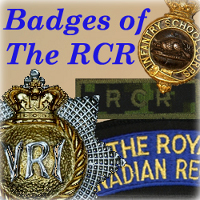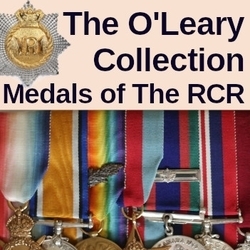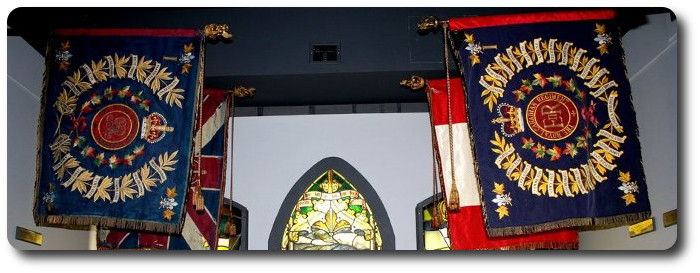
Researching The Royal Canadian Regiment
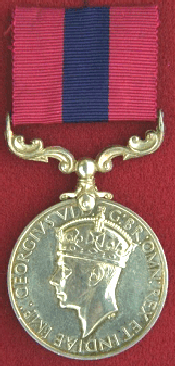
The Distinguished Conduct Medal, awarded to Warrant Officers, non-commissioned officers, and men, serving in any of the sovereign's military forces, for distinguished conduct in the field. The DCM was created on 04 December 1854, because of the Crimea War and was first awarded to a Canadian on 19 April 1901. There were 2,132 awards to Canadian Army and RCAF personnel, plus 38 first bars and 1 second bar.
Source: Veterans Affairs Canada (Medal description)
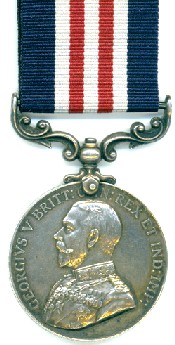
The Military Medal, awarded to Warrant Officers, non-commissioned officers and men for individual or associated acts of bravery on the recommendation of a Commander-in-Chief in the field. Canadians have received 13, 654 medals, plus 848 first bars and 38 second bars. The medal was instituted on 25 March 1916.
Source: Veterans Affairs Canada (Medal description)
The Forgotten Hero
460196 Private Charles Robertson Peterson Thompson, DCM and Bar, MM.
By: Warrant Officer Ross Appleton, CD; The 1st Battalion, The Royal Canadian Regiment.
Private Charles Robertson Peterson "Pete" Thompson was a member of The Royal Canadian Regiment from 1916 to 1919. During his distinguished First World War service, Thompson was cited for gallantry in action on three separate occasions. He was subsequently awarded the Distinguished Conduct Medal twice, while additionally receiving the Military Medal (see Note 1). The winning of these three medals for gallantry make Private Thompson the most decorated enlisted man in the history of The Royal Canadian Regiment. As well, he was the most decorated private solider in the Canadian Army during the First World War.
Pete Thompson was born at Smiths Falls, Ontario on 7 November 1886. Tragedy struck the Thompson family when Pete's father, a well-known Ontario police detective, was killed in the line of duty. In consequence, the young boy and his family moved west to Winnipeg, Manitoba. Here, Thompson eventually married and made his living as a baker.
The Great War erupted in August 1914 with Canada involved as part of the British Empire. Thompson promptly attempted to enlist in the overseas army. However, he was initially denied as the result of a childhood mishap that had left him with the permanent disability of a metal plate in his head. Thompson was allowed to serve with the Active Militia of Winnipeg, in the 106th Regiment. In 1915, with casualties increasing on the Western Front, the 61st Infantry Battalion (Canadian Expeditionary Force) was mobilized in Winnipeg for overseas duty. Despite his disability, Pete Thompson once again volunteered and, on 3 June 1915, was finally accepted. He was 28 years old.
Private Thompson remained in Canada over the next ten months training with the 61st Battalion. On 1 April 1916, he sailed for England with his unit. Once in England, the 61st Battalion was absorbed into the 11th Reserve Battalion of the Canadian Training Depot. Thus, on 4 June 1916, one year after he had enlisted, Thompson was dispatched to France and active service as an individual augmentee. On 14 June he was taken on strength with The Royal Canadian Regiment.
At this time the Regiment had just finished its involvement in the fighting at Mount Sorrel. While Thompson served with the RCR, the Regiment would fight in such battles as the Somme (Sep - Oct 1916); Flers-Courcelette (Sep 1916); Ancre Heights (Oct 1916); Vimy Ridge (Apr 1917); Hill 70 (Apr - Oct 1917); and Third Ypres (Oct - Nov 1917).
It was in the Ypres Salient, in the late Fall of 1917, that Private Thompson would perform heroically as a company runner during the grim fighting for Passchendaele Ridge. In early November he was cited for gallantry and recommended for the Military Medal. The citation for his first decoration for bravery in action reads:
"In the attack on PASSCHENDALE RIDGE, for conspicuous bravery and devotion to duty during the operations on 30th October, to 3rd November 1917, as a runner and Guide. Time after time with unvarying successes he guided in numerous Rations, Water, Carrying and stretcher Parties, avoiding with great skill, places heavily shelled by the enemy. By his personal coolness, disregard of danger and consistent good work, he was invaluable to his Company Commander."
Within days of being recognized for gallantry, Thompson would win the first of his two Distinguished Conduct Medals as related by the following citation:
"During the operations on Passchendaele Ridge. For conspicuous gallantry and devotion to duty from Nov 14 to Nov 17, 1917. During three days and nights of incessant bombardment, Private Thompson, in addition to performing his duties as Runner and guiding in numerous Ration and Water Parties and taking out wounded with unfailing success, was untiring in his efforts in digging out buried men and tending the wounded under heavy shelling showing himself utterly regardless of personal danger in his efforts to help others. In a peculiarly scattered position of funk holes, unconnected with each other, Private Thompson's work was of the greatest possible assistance to his Company Commander. By his great coolness and personal bravery Private Thompson set a splendid example to the Company, and by his extraordinary knowledge of the ground, undoubtedly saved many men's lives."
Attritional trench warfare continued after Passchendaele until the British counter-offensive at Amiens on 8 August 1918. Thompson was part of the great forward movement of Allied armies, present at such battles as Amiens; Arras and the Scarpe (Aug 1918); the Hindenburg Line (Sep 1918); Canal du Nord (Sep 1918); and Cambrai (Sep - Oct 1918), where Lieutenant Milton F. Gregg won the Victoria Cross.
Following the action at Cambrai, Private Thompson was recommended for promotion to Lance Corporal on 6 October 1918. It was during the final campaign of the war, the climactic pursuit to Mons, that Pete Thompson would distinguish himself as a section commander. In particular, it was in the fighting in and around Mons that he would perform heroically. The citation for Thompson's second D.C.M. reads:
"For conspicuous gallantry and able leadership during the operations at Mons on November 10th and 11th 1918. When the advance was held up by hostile fire directed from the slagheap in J. 29 and 35, Private Thompson advanced with his section and put the post out of action. The advance was then continued rapidly towards the Jurbise-Mons road where Private Thompson, with his section, seized its crossing over the Canal Du Contre and beat off a hostile counter attack at this point. This man's work was magnificent throughout the operations. His section secured the most important results to the advance. Previously awarded D.C.M. and M.M."
The First World War ended on 11 November 1918. For the next several weeks The Royal Canadian Regiment remained in Belgium on garrison duties. Pete Thompson was officially promoted to Lance Corporal on 22 January 1919. Finally, on 6 February, he and the Regiment departed the Continent. The RCR sailed from England on 1 March, arriving in Halifax aboard the S.S. Adriatic on 9 March.
Lance Corporal Charles Robertson Peterson Thompson was honourably discharged from the CEF on 23 March 1919. He had served for three years and 276 days. The records indicate that he returned to his wife, Gertrude, and his former civilian occupation at Winnipeg, Manitoba. Eventually Thompson and his growing family would move further west and take up residence in Vancouver, British Columbia. In 1939 he was selected to represent The Royal Canadian Regiment on an Honour Guard that received King George VI and Queen Elizabeth on their state visit to Vancouver. Thompson, an extremely modest man, rarely spoke of his wartime exploits. Indeed, he refused to be associated with those who exaggerated their military service without ever having been near the front lines. It was in Vancouver, on 23 October 1958, that Pete Thompson passed away at the age of 72 years (see Note 2).
Private Thompson is worthy of special recognition. Indeed, he should hold a unique position in the annals of The Royal Canadian Regiment. No other soldier of the Regiment was more decorated for gallantry in action. During the First World War 1,947 members of the Canadian Expeditionary Force were awarded the Distinguished Conduct Medal. Of these only 36, including Thompson, went on to subsequently win a second DCM. Of this elite group, only seven, again including Thompson, had also received the Military Medal.
In the history of The Royal Canadian Regiment only Pete Thompson was a double recipient of the DCM. His was not the isolated courage of a single brave act; rather his three citations for gallantry indicate a splendid pattern of heroic behaviour over a protracted and bloody period of sustained combat. Private Thompson was consistently a brave soldier who could lead and inspire the men with whom he served.

NOTE 1
The Victoria Cross, for both officers and men, was the highest award for gallantry in action. It was awarded for "most conspicuous bravery or some daring or pre-eminent act of valour or self-sacrifice or extreme devotion to duty in the presence of the enemy". In issue since 1856, only 94 have been awarded to Canadians. Only one member of The Royal Canadian Regiment, Lieutenant Milton F. Gregg, a commissioned officer, has won this medal. For other ranks the second highest award for gallantry in action was the Distinguished Conduct Medal. Warrant Officers, non-commissioned officers, and men could be awarded the DCM who had "performed service of a distinctly gallant and distinguished nature in action in the field." Created in 1854, the DCM was first awarded to a Canadian in 1901. Although 2,132 Canadians have received this medal only 38 of these were to subsequently win a second DCM. A total of 30 soldiers from The Royal Canadian Regiment have won the Distinguished Conduct Medal. Of these, only Private Pete Thompson was awarded the DCM twice. For enlisted men the Military Medal rated third after the VC and DCM as an award for gallantry in action. The MM was awarded to Warrant Officers, non-commissioned officers and men "for individual or associated acts of bravery and devotion under fire on the recommendation of a Commander-in-Chief in the field". First issued in 1916, Canadians have received this medal on 13,654 occasions. A total of 164 members of The Royal Canadian Regiment have won the Military Medal.
NOTE 2
The Vancouver Sun; British Columbia; Saturday, Oct, 25, 1958
THOMPSON: C.R. "Pete" Thompson M.M. DCM and bar. Late of 2915 E. 29th Ave, Vancouver, BC. Passed away 23 October 1958, aged 72 years. Survived by his wife; 3 sons, Ear, Portage La Prairie, Man; Gordon of Haney and Charles of Duncan; 1daughter, Mrs. Marie Lepetich of Soda Creek, BC; 5 grandchildren, 2 brothers Aubrey, White Rock: Goldman of Detroit Mich: 2 sisters, Mrs. F. Cartwright and M. Riely of Langley. Funeral will be held in Columbia funeral chapel New Westminister, Monday, Oct 27 at 3:30 pm. Rev F.A. Ramsey officiating. Interment Valley View Memorial Gardens.

